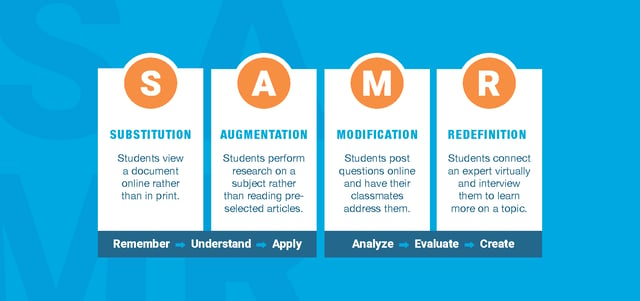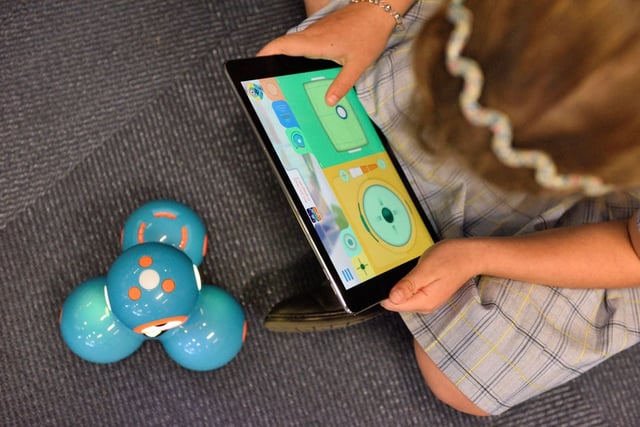What the History of Personalized Learning Teaches Us About It Today
 Insights By Anna McVeigh-Murphy
Insights By Anna McVeigh-Murphy
I’m a bit of an historian by nature and often compare and contrast the past with the present. This sort of practice offers a lot of perspective about contemporary topics. After all, we didn’t just end up in this place, both literally and figuratively. In order grasp the meaning and intention of personalized learning and pursue its promised benefits, it’s important to start with the history behind it as well.
As 21st century as it may seem, personalized learning has its roots in early American history. More than that, it’s a product of a centuries-long, and uniquely American, quest for an educated and informed democracy.
A Founding Father’s Vision
The following two sections are informed by John Dockterman’s research, which can be found here.Enter Thomas Jefferson. As the revolutionary war was raging on, Thomas Jefferson introduced a bill to the Virginia state legislature, calling for the formation of a public system that provided citizens with educational opportunities “without regard to wealth, birth or other accidental condition or circumstance.” In Jefferson’s eyes, education was essential to the “preservation of freedom and happiness.”
And it makes sense, democracies need discerning and informed voters, independent and critical thinkers, and capable and equipped workers. However, this was a massive departure from the disparate and deeply inadequate education system that came before. While the bill was ultimately rejected, it’s relevant here because it, one, aligns the success of democracies with education, and it, two, sets in motion the pursuit of a public education system.
**I cannot fail to add that people of color and women were not included in Jefferson’s legislation.
Then, as the nineteenth century commenced, popular opinion embraced the concept of public, universal education, which is where we meet the second character in this saga, John Lancaster.
The Fabled Schoolhouse
In the four walls of the fabled schoolhouse, Lancaster introduced what we would now call a competency-based model of education, known as the Lancaster System or the Monitorial System.
Under the system, students were grouped based on competency levels in reading, writing, and math. To accommodate the groupings, the learning progression was mapped into sequences with students being assigned to different sequences based on ability. Because the progressions were specific to each content area, a student may be in a beginner sequence in math but a more advanced reading sequence.
The lessons were then delivered by more expert students called monitors, while the teacher oversaw the entire process. Students progressed alongside their skills and would repeat sequences as needed, giving a nod to mastery-based education.
The Stuff of Urban Legend Reality
As the century progressed, the Lancasterian model was popularized and spread both within the United States and abroad, continuing until the end of the century. The eventual move away from this system was a byproduct of urbanization in the United States, which resulted in overcrowding in cities and, in our case, the overcrowding of schools.
With rising student populations, the small-group model was overwhelmed and untenable for the infrastructure and capacity of most urban schools. In response to these existential forces, age grading, meaning students were grouped into classrooms based on age, became the new norm. The logic was that students of a similar age were expected to have a shared level knowledge and skills, the capacity to learn at a similar pace, and a propensity to learn in like ways.
This premise of age grading gave way, as Dockterman explains, to a system of accountability built around grade-level expectations: standards and standardized tests, retention and graduation rates.
Classrooms housed neat rows of students with a teacher delivering a lecture at the front to drill in a prescribed list of knowledge and skills that would then be assessed. Under this system, student performance was reflected in a normal distribution along a bell curve, believing that student capability was fixed with inevitable pockets of high-achievers and low-performers and a majority of students clumped somewhere in the middle.
Sound familiar? That’s because it is the model of schooling that has continued through today.
The Now-Infamous Factory Model
Most have probably heard this maligned to the factory model of schooling. And in a lot of ways, this is an apt metaphor – student knowledge built along on an assembly line of instruction that compounds from grade to grade, or rather workstation to workstation. The flaw is that learning isn’t conducive to standardization. So rather than students graduating with equal sets of knowledge and skills, the result is quite the opposite.
In sticking with the factory metaphor, students don’t start off the same and they don’t learn in the same way so one-size-fits-all parts don’t fit, fall off, or tenuously cling to the structure, and what results is discombobulated and incomplete.
That said – and here is where historical context is necessary – this approach is a result of the economic reality of the time. The sort of mass urbanization that happened under the industrial revolution had never been seen in modern history before. Sprawling populations challenged almost every tentacle of public services, and the results, like in education, persist today.
At the time, a standardized, age-graded approach was a tangible solution, however strenuous, to overcome the preeminent challenges spawned by mass urbanization. Moreover, the so-called factory model of schooling’s intention wasn’t necessarily to funnel people to factories. Instead, it was an effort (at its best and in the most optimistic light) to preserve the right to education for the “preservation of freedom and happiness.”
A Tale of Student-Centric Reforms
Now for a lightning round of student-centric reforms.
Recognizing the flaws of the factory-like system, we meet John Dewey, who in his 1912 book advocated for: “the growth of learners in small learning communities where they can discuss and uphold the American ideals of democracy.”
And in the latter part of the twentieth century, non-age-graded schools began to arise (again) in pursuit of a student-centered instructional model, recognizing the deep flaws in a standardized and assembly line-esque model.
At this time, we also meet Fred Keller and his Keller plan, which introduced a Personalized System of Instruction that was an individualized, competency-based approach to education.
Then, in the 1970s comes Benjamin Bloom’s research on mastery learning. His study found that a mastery-based environment, compared to a conventional approach, significantly increased student performance; and when students were paired with tutors in a mastery-based, one-to-one environment, these students significantly outperformed their conventionally taught peers and their solely mastery-taught peers.
Because restructuring entire school districts and hiring an abundance of classroom tutors is expensive and timely, these reforms have most often been to the benefit of private school students, students in wealthy districts, or those attending charter schools. So, the factory model that persists today exists in under-served communities with a more concentrated population of immigrants and people of color. This disparity only deepens inequity in our education system.
Personalized Learning for Today
Despite the advocacy, proven benefits, and re-introduction of non-age-graded schools, a scalable model still does not exist. Whether due to financial limitations, pedagogical stagnation, or entrenched accountability systems, personalized learning struggles to find a foothold and grow at scale.
If personalized learning is to finally answer the call of democracy for an equitable system of education, we must reframe what personalized learning entails so that it evolves to fit within present circumstances. Maybe personalized learning can exist outside of non-age graded schools, in schools with larger populations, and within the current accountability system. But this brand of personalized learning looks different.
What most distinguishes the present from the past is access to transformative technology that can redefine what personalized learning looks like and the contexts in which it can exist.
Technology dissipates the need for a one-to-one (teacher-to-student) environment, and technology helps to facilitate instructional delivery and guide students through activities and projects. Does this sound like the monitorial system? Yes.
It goes further though: technology even delivers formative assessments that are often built into the learning interface and creates adaptive learning experiences that tailor to students’ skill level, so all students move toward mastery.
With technology, teachers have the opportunity to connect with students and act as facilitators of impactful learning experiences. With access to rich data, teachers are better able to strategize in their classroom planning and the support they provide students. Students are more engaged, and they set goals for their learning, see their own growth, and take agency in the process. With access to abundant resources, students inform how they learn and connect with their teachers in collaborative and newly imagined ways.
- Examples of what this can look like include:
- This Ted Talk exploring the introduction of mastery-based learning in Title I schools.
- This interview with a district CTO sharing the strategy behind their highly personalized, blended learning environment.
- This research piece investigating a city-wide personalized learning endeavor.
Personalized, mastery-based learning isn’t new, as history has shown, but technology integration in learning is.
Indeed, technology has disrupted nearly every industry, fundamentally changing the nature of work and how we experience the world around us. And it has democratized everything from information to creativity. Is it time for technology to democratize learning, and through this answer the call of the American democratic experience?
This article was originally published on Schoology Exchange.






